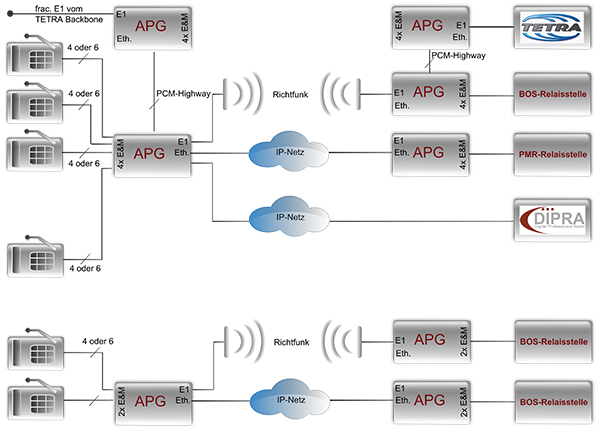Digital Processing and Transmission of analog Audio and Signaling 
The Audio Processing Gateway APG is a means to exploit inexpensive digital lines like Ethernet or E1 TDMA links for analog audio and signaling. Apart from transcoding voice between the various standards (e.g. VoIP, G.711), signal streams whether analog or digital, are processed to identify and analyze signaling.
High processing power combined with modular software structures enable a very flexible response to changing functional requirements. Options are included to decode and encode signaling schemes like CTCSS, DTMF and tones for selective calling according to standards from ZVEI, EIA etc.
Some examples how an APG may be deployed:
1. Basestations and Dispatchers
Basestations and dispatcher stations of PMR radio networks very often are connected by means of analog tie-lines. In many countries these lines are not available any more or are unacceptably expensive.
In case of a dispatcher station, APGs terminating at both ends of an IP network may serve as a replacement for a leased analog tie-line.
An IP network may cause high and varying packet jitter and introduces significant latency. Thus, using APGs to connect basestations with signaling as part of an air interface protocol, the acceptable time delay for acknowledgement response sometimes may be exceeded. The APG provides a function to generate such acknowledgements locally instead, in order to avoid violation of protocol rules and expected response times for acknowledgements.
2. Connecting MPT-1327 Trunked Basestations
Normally, MPT-1327 basestations are equipped with multiple radio channels and therefore always required a number of analog tie-lines. These again often can be replaced by a single pair of APGs, which are interconnected using IP or E1 TDMA lines. One pair of APGs serves as the equivalent of four analog duplex lines.
3. TETRA and analog Basestations at the same Site
In this example an E1-link, wire line or microwave, terminates at the basestation site. Utilizing APGs facilitates a fractional E1 interface to interconnect to the TETRA basestation and to provide one or more interfaces to analog basestations.


